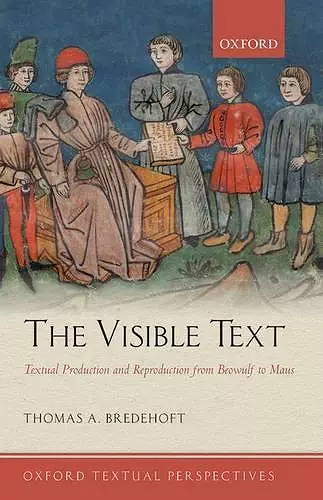The Visible Text
Textual Production and Reproduction from Beowulf to Maus
Format:Hardback
Publisher:Oxford University Press
Published:16th Jan '14
Currently unavailable, and unfortunately no date known when it will be back
This hardback is available in another edition too:
- Paperback£30.99(9780199603152)

Oxford Textual Perspectives is a new series of informative and provocative studies focused upon literary texts (conceived of in the broadest sense of that term) and the technologies, cultures and communities that produce, inform, and receive them. It provides fresh interpretations of fundamental works and of the vital and challenging issues emerging in English literary studies. By engaging with the materiality of the literary text, its production, and reception history, and frequently testing and exploring the boundaries of the notion of text itself, the volumes in the series question familiar frameworks and provide innovative interpretations of both canonical and less well-known works. Covering materials ranging from Anglo-Saxon manuscripts and inscribed objects to contemporary comics, The Visible Text rewrites the history of textual media and technologies. Arguing that media are not defined by technologies alone, but by a combination of technologies and the ideas that people hold about those technologies, Bredehoft identifies four distinct periods or domains in the history of English literature that correspond to four ways in which media ideologies interacted with the two basic defining technologies of manuscripts and printed books. Examining two complementary ways of defining texts (as subject to a reproductive medium, on the one hand, and as surrounded and defined by paratexts, on the other), The Visible Text points out how Anglo-Saxon manuscripts and contemporary comics share a remarkable similarity in being structured as productions rather than reproductions. Contrastingly, the late-medieval and print-era periods share a cultural investment in textual reproduction, but they differ both in their characteristic technologies and in how they conceptualize the object of reproduction itself. A final epilogue, briefly considering the nature of electronically-mediated textuality, highlights the importance of understanding the history addressed here, as electonic text both parallels and departs from typographic print in ways that earlier reproductive domains clarify and complicate. Filled with concrete examples of both books and texts, The Visible Text will be of interest to readers in the fields of literature, book history, literary theory, media studies, and visual culture.
ISBN: 9780199603169
Dimensions: 209mm x 141mm x 15mm
Weight: 334g
194 pages